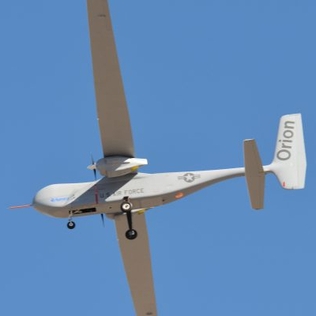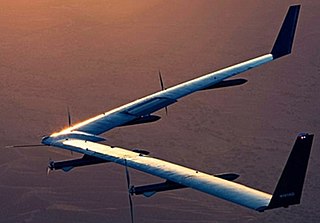
The MacCready Gossamer Condor was the first human-powered aircraft capable of controlled and sustained flight; as such, it won the Kremer prize in 1977. Its design was led by Paul MacCready of AeroVironment, Inc.

The NASA Pathfinder and NASA Pathfinder Plus were the first two aircraft developed as part of an evolutionary series of solar- and fuel-cell-system-powered unmanned aerial vehicles. AeroVironment, Inc. developed the vehicles under NASA's Environmental Research Aircraft and Sensor Technology (ERAST) program. They were built to develop the technologies that would allow long-term, high-altitude aircraft to serve as atmospheric satellites, to perform atmospheric research tasks as well as serve as communications platforms. They were developed further into the NASA Centurion and NASA Helios aircraft.

AeroVironment, Inc. is an American defense contractor headquartered in Arlington, Virginia, that designs and manufactures unmanned aerial vehicles (UAVs). Paul B. MacCready Jr., a designer of human-powered aircraft, founded the company in 1971. The company is best known for its lightweight human-powered and solar-powered vehicles. The company is the US military's top supplier of small drones — notably the Raven, Switchblade, Wasp and Puma models.

An electric aircraft is an aircraft powered by electricity. Electric aircraft are seen as a way to reduce the environmental effects of aviation, providing zero emissions and quieter flights. Electricity may be supplied by a variety of methods, the most common being batteries. Most have electric motors driving propellers or turbines.

The Environmental Research Aircraft and Sensor Technology, or ERAST program was a NASA program to develop cost-effective, slow-flying unmanned aerial vehicles (UAVs) that can perform long-duration science missions at altitudes above 60,000 ft (18,000 m). The project included a number of technology development programs conducted by the joint NASA-industry ERAST Alliance. The project was formally terminated in 2003.

The Zephyr is a series of high-altitude platform station aircraft produced by Airbus. They were designed originally by QinetiQ, a commercial offshoot of the UK Ministry of Defence. In July 2010, the Zephyr 7 flew during 14 days. In March 2013, the project was sold to Airbus Defence and Space. In the summer of 2022, the Zephyr 8/S flew during 64 days.

An Atmospheric satellite or pseudo-satellite is a long endurance, high altitude aircraft able to offer observation or communication services similarly to artificial satellites. Mostly unmanned aerial vehicles (UAVs), they remain aloft through atmospheric lift, either aerodynamic like airplanes, or aerostatic like airships or balloons. High-altitude long endurance (HALE) military drones can fly above 60,000 ft over 32 hours, while civil High-altitude platform station (HAPS) are radio stations at an altitude of 20 to 50 km above a fixed point.

The Helios Prototype was the fourth and final aircraft developed as part of an evolutionary series of solar- and fuel-cell-system-powered unmanned aerial vehicles. AeroVironment, Inc. developed the vehicles under NASA's Environmental Research Aircraft and Sensor Technology (ERAST) program. They were built to develop the technologies that would allow long-term, high-altitude aircraft to serve as atmospheric satellites, to perform atmospheric research tasks as well as serve as communications platforms. It was developed from the NASA Pathfinder and NASA Centurion aircraft.

Aurora Flight Sciences is an American aviation and aeronautics research subsidiary of Boeing which primarily specializes in the design and construction of special-purpose Unmanned aerial vehicles. Aurora has been established for 20+ years and their headquarters is at the Manassas Regional Airport in Manassas, Virginia.
The Boeing HALE is a concept for "high altitude, long endurance" unmanned aerial vehicles.
The AeroVironment Global Observer is a concept for a high-altitude, long endurance unmanned aerial vehicle, designed by AeroVironment (AV) to operate as a stratospheric geosynchronous satellite system with regional coverage.

The NASA Centurion was the third aircraft developed as part of an evolutionary series of solar- and fuel-cell-system-powered unmanned aerial vehicles. AeroVironment, Inc. developed the vehicles under NASA's Environmental Research Aircraft and Sensor Technology (ERAST) program. They were built to develop the technologies that would allow long-term, high-altitude aircraft to serve as atmospheric satellites, to perform atmospheric research tasks as well as serve as communications platforms. It was developed from the NASA Pathfinder Plus aircraft and was developed into the NASA Helios.

The AeroVironment RQ-20 Puma is an American unmanned aircraft system which is small, battery powered, and hand-launched. Its primary mission is surveillance and intelligence gathering using an electro-optical and infrared camera. It is produced by AeroVironment.

World View Enterprises, Inc., doing business as World View, is a private American near space exploration and technology company headquartered in Tucson, Arizona, founded with the goal of increasing access to and the utilization of the stratosphere for scientific, commercial, economic, and military purposes.

The Orion is a Medium-altitude long-endurance unmanned aerial vehicle (UAV) developed by Aurora Flight Sciences.
This is a list of aviation-related events in 2018. The deadliest crash of this year was 2018 Algerian Air Force Ilyushin Il-76 crash which crashed on 11 April 2018 killing all 257 on board.

The Facebook Aquila is an experimental solar-powered drone developed by Facebook for use as an atmospheric satellite, intended to act as relay stations for providing internet access to remote areas. It first flew on 28 June 2016 with a second aircraft successfully flying in 2017. Internal development of the Aquila aircraft was stopped in June 2018.
The Odysseus is a solar, High-Altitude Long Endurance drone developed by Aurora Flight Sciences.
This is a list of aviation-related events in 2019. The deadliest crash of this year was Ethiopian Airlines Flight 302 which crashed on 10 March 2019 killing all 157 on board.














